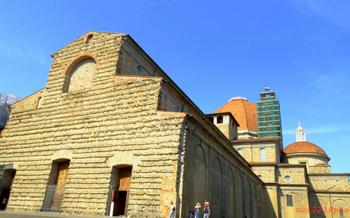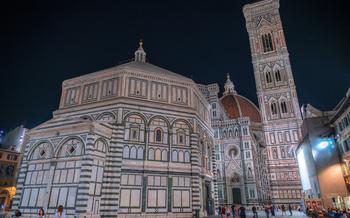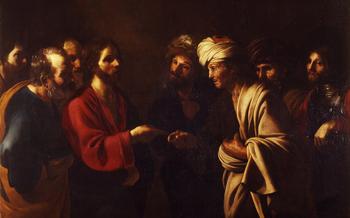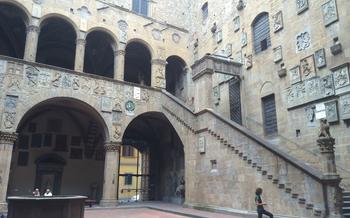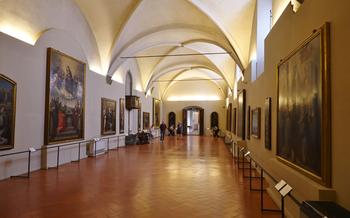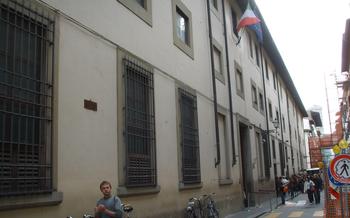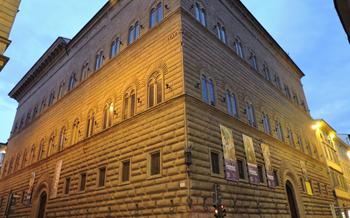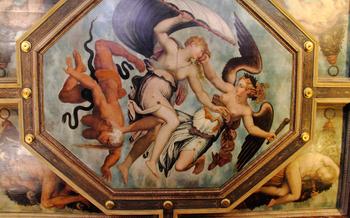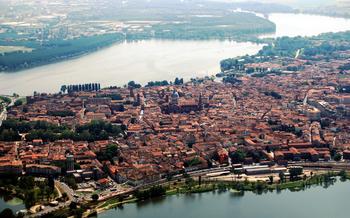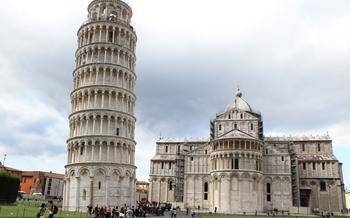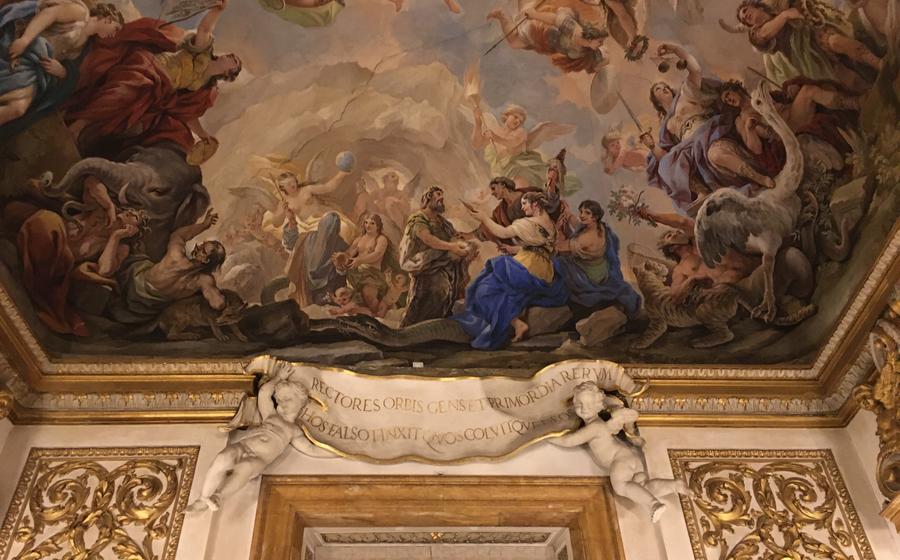
Palazzo Medici Riccardi
- Introduction - The Allure of Florence and Palazzo Medici Riccardi
- Historical Significance
- Architectural Masterpiece: A Fusion of Power and Elegance
- Medici Family Symbolism: Power and Legacy Etched in Stone
- Chapel of the Magi - Benozzo Gozzoli's Masterpiece
- Salone dei Papi - Celebrating Papal Power and Medici Prestige
- Loggia - A Serene Courtyard with a View
- Oratory of the Magi - Hidden Gem of Religious Devotion
- Medici Archive - A Treasure Trove of Historical Documents
- Biblioteca Riccardiana - A Haven for Book Lovers
- Palazzo Medici Riccardi Café - A Culinary Delight
- Accessibility and Practical Information
- Surrounding Area - Exploring the Heart of Florence
- Insider Tip - Discovering Hidden Treasures:
Introduction - The Allure of Florence and Palazzo Medici Riccardi
Florence, the birthplace of the Renaissance, is a city that captivates hearts with its artistic treasures, architectural marvels, and rich history. Among its many iconic landmarks, Palazzo Medici Riccardi stands as a testament to the city's grandeur and the enduring legacy of the Medici family. This magnificent palace, with its imposing façade and elegant courtyard, is a must-visit destination for anyone seeking to delve into the heart of Florentine history and culture.
Palazzo Medici Riccardi, commissioned by Cosimo de' Medici in the 15th century, embodies the transition from Gothic to Renaissance architecture. Its design, attributed to Michelozzo di Bartolomeo, seamlessly blends classical elements with the rusticated stonework characteristic of Florentine palaces. The result is a harmonious and visually stunning masterpiece that reflects the Medici's power and influence during the Florentine Renaissance.
Historical Significance
The Medici family, hailing from humble origins in the Tuscan countryside, rose to prominence in Florence during the 15th century. Through their shrewd political acumen and financial prowess, they established themselves as the de facto rulers of the city, shaping its destiny for over two centuries. Their influence extended beyond Florence's borders, as they became patrons of the arts, humanists, and scholars, contributing to the city's transformation into the cradle of the Italian Renaissance.
The construction of Palazzo Medici Riccardi, commissioned by Cosimo de' Medici in 1444, epitomizes the family's rise to power and their desire to assert their dominance. The palace, designed by Michelozzo di Bartolomeo, was a bold statement of their wealth and influence. Its imposing façade, elegant courtyard, and grand staircases symbolized the Medici's transition from wealthy merchants to powerful rulers.
Throughout Florentine history, Palazzo Medici Riccardi served as a focal point of political and social life. It hosted lavish banquets, diplomatic meetings, and cultural gatherings, cementing the Medici's position as the city's leading family. The palace's walls witnessed the rise and fall of Medici fortunes, political intrigue, and artistic triumphs, making it an enduring symbol of Florence's rich and complex past.
Architectural Masterpiece: A Fusion of Power and Elegance
The Palazzo Medici Riccardi stands as a testament to the architectural brilliance of the early Renaissance. Commissioned by Cosimo de' Medici in 1444, the palace was designed by Michelozzo di Bartolomeo, a renowned architect of the period. The result is a harmonious blend of classical and medieval elements, reflecting both the Medici family's power and their appreciation for the arts.
The imposing façade of the palace is a masterpiece of rusticated stone, a technique that involves using rough-hewn blocks of stone to create a textured surface. This verleiht dem Gebäude ein Gefühl von Stärke und Beständigkeit. The rusticated stonework is complemented by elegant classical elements, such as pilasters, cornices, and pediments, which add a sense of refinement and grandeur.
One of the most striking features of the Palazzo Medici Riccardi is its grand courtyard. Surrounded by an arcade of graceful arches, the courtyard is a tranquil oasis in the heart of Florence. The elegant loggia, with its slender columns and intricate carvings, provides a glimpse into the Medici family's love for beauty and symmetry.
The palace's interior is no less impressive. The grand staircases, with their sweeping curves and intricate balustrades, lead to a series of lavishly decorated rooms. The walls are adorned with frescoes by renowned Renaissance artists, depicting scenes from mythology, history, and the Medici family's own illustrious past.
The Palazzo Medici Riccardi is a true architectural masterpiece, showcasing the fusion of power and elegance that characterized the Medici family and the early Renaissance. Its harmonious blend of classical and medieval elements, its meticulous attention to detail, and its stunning interior decorations make it a must-see destination for anyone interested in architecture, art, or history.
Medici Family Symbolism: Power and Legacy Etched in Stone
The Medici family left an indelible mark on Palazzo Medici Riccardi, not only through their architectural patronage but also through their symbolic representation. The Medici coat of arms, featuring six red balls arranged in a 2-2-2 formation, is omnipresent throughout the palace, serving as a reminder of their power and influence. This distinctive symbol adorned everything from the palace's façade to its interiors, asserting the family's dominance in every corner.
Beyond the coat of arms, the palace is replete with allegorical frescoes and sculptures that celebrate the Medici lineage and achievements. These artworks often depict mythological scenes or historical events, subtly weaving in references to the family's virtues, triumphs, and aspirations. The Sala di Lorenzo il Magnifico, for instance, features a fresco by Benozzo Gozzoli portraying the Medici family as the Three Kings, paying homage to their generosity and political acumen.
The Medici's legacy extends beyond the walls of their grand palace. Their patronage of the arts, their political prowess, and their cultural influence shaped the very identity of Florence. The city's artistic heritage, its vibrant cultural scene, and its status as a Renaissance hub are all testaments to the enduring impact of the Medici family.
Chapel of the Magi - Benozzo Gozzoli's Masterpiece
In the heart of Palazzo Medici Riccardi, a hidden gem awaits visitors - the Chapel of the Magi, adorned with stunning frescoes by the renowned Renaissance artist Benozzo Gozzoli. Step into this sacred space and be transported to a biblical realm through the artist's vivid depiction of the Procession of the Magi.
As you gaze upon the walls, you'll be captivated by the vibrant colors and intricate details that bring the biblical narrative to life. Gozzoli's innovative techniques, such as the use of perspective and realistic portraiture, create a truly immersive experience, drawing you into the scene and allowing you to witness the journey of the Magi as if you were there.
The chapel's serene atmosphere, coupled with the masterful storytelling of Gozzoli's frescoes, offers a moment of contemplation and reflection. Let the biblical theme, with its symbolism of faith and devotion, inspire you as you admire the beauty of this sacred space.
Discover the Chapel of the Magi, a testament to Benozzo Gozzoli's artistic genius and a true highlight of Palazzo Medici Riccardi's cultural treasures.
Salone dei Papi - Celebrating Papal Power and Medici Prestige
The Salone dei Papi (Hall of the Popes) stands as a testament to the Medici family's profound ties with the Catholic Church and their unwavering commitment to asserting their authority. This grand hall, measuring 23 meters in length and 10 meters in width, exudes an aura of opulence and grandeur that is befitting of its purpose. The coffered ceiling, adorned with intricate carvings and gilded details, adds to the sense of awe and reverence that permeates the space.
The walls of the Salone are adorned with a series of striking frescoes depicting portraits of popes and Medici family members, silently narrating the intertwined histories of these two powerful entities. The portraits, executed by renowned artists of the time, serve as a visual testament to the close relationship between the Medici and the papacy. The hall's prominent display of these portraits underscores the Medici's desire to showcase their deep-rooted connections with the highest echelons of the Catholic hierarchy.
The Salone dei Papi served as a grand reception hall where the Medici family hosted lavish banquets, diplomatic meetings, and other important events designed to showcase their power and prestige. The hall's impressive dimensions and ornate decorations were carefully orchestrated to create an overwhelming sense of grandeur and awe, leaving a lasting impression on visitors and solidifying the Medici's position as the preeminent family of Florence.
Loggia - A Serene Courtyard with a View
Nestled within the heart of Palazzo Medici Riccardi, the loggia offers a tranquil oasis, inviting visitors to immerse themselves in serenity and beauty. This graceful arcade, embraced by lush greenery, exudes an air of tranquility that is a stark contrast to the bustling city outside.
In the early days, when the Medici family called this palace home, the loggia served as an intimate retreat, a private garden where family members could stroll, converse, and enjoy the fresh air. The soothing sound of water trickling from the fountain in the center of the courtyard would create a serene ambiance, perfect for contemplation or intimate gatherings.
From the loggia, visitors can capture breathtaking views of the surrounding gardens, a tapestry of colorful blooms and manicured hedges, a true testament to the Medici's love for nature and aesthetics. The panorama extends beyond the gardens, encompassing the rooftops of Florence, with the majestic Duomo dominating the skyline.
Taking a moment to pause and savor the tranquility of the loggia, visitors can almost feel the presence of the Medici family, who once graced these very grounds. It is easy to imagine Cosimo de' Medici, the patriarch of the dynasty, gazing out at the city he ruled with wisdom and power, or Lorenzo the Magnificent, the epitome of Renaissance brilliance, engaging in philosophical discussions with his court.
The loggia stands as a testament to the Medici's appreciation for harmony and balance, a sanctuary where they could escape the demands of their public lives and find solace in nature's embrace. Today, visitors to Palazzo Medici Riccardi can experience the same sense of serenity, stepping into a hidden gem that reveals the softer, more private side of the Medici legacy.
Oratory of the Magi - Hidden Gem of Religious Devotion
Adjacent to the Salone dei Papi lies a hidden treasure, the Oratory of the Magi. Constructed in the 15th century as a private chapel for the Medici family, this intimate space exudes an atmosphere of serenity and devotion. The oratory's walls are adorned with exquisite frescoes depicting scenes from the life of Christ and the Magi, attributed to the renowned artists Fra Angelico and Benozzo Gozzoli.
Fra Angelico's frescoes on the left wall narrate the story of the Annunciation, the Nativity, and the Adoration of the Magi. The vibrant colors and meticulous details of these paintings captivate visitors, offering a glimpse into the divine realm. Benozzo Gozzoli's frescoes on the right wall depict the Procession of the Magi, echoing the theme of the Magi Chapel. The ornate procession, filled with exotic animals and richly dressed figures, unfolds against a backdrop of rolling hills and distant cities.
The intricate iconography of the frescoes reveals the deep religious devotion of the Medici family. The Magi, representing the three wise men who followed the star to Bethlehem, symbolize the journey of faith and the search for spiritual enlightenment. The presence of Cosimo de' Medici, portrayed as one of the Magi, further emphasizes the personal connection between the family and this sacred space.
In the center of the oratory, a delicate wooden altar holds a 15th-century crucifix attributed to Donatello. The soft lighting, the intricate frescoes, and the serene atmosphere create a contemplative space where visitors can find solace and reflection, away from the bustling crowds of the palace.
Medici Archive - A Treasure Trove of Historical Documents
The Palazzo Medici Riccardi houses the Medici Archive, a treasure trove of historical documents that offer a glimpse into the lives and reign of one of Italy's most influential families. The archive contains a vast collection of letters, manuscripts, and financial records, meticulously preserved and cataloged over the centuries. For scholars and historians, the Medici Archive is an invaluable resource, providing insights into the political, economic, and cultural landscape of Renaissance Florence.
The documents in the archive span several centuries, offering a comprehensive record of the Medici family's rise to power, their patronage of the arts, and their involvement in international diplomacy. Researchers can delve into the intricacies of Medici financial transactions, their correspondence with other powerful families, and their relationships with artists and intellectuals. The archive also sheds light on the daily lives of the Medici, their personal interests, and their interactions with the Florentine people.
Preserving and maintaining such a vast collection of historical documents is a significant undertaking. The staff of the Medici Archive works diligently to ensure the proper storage and conservation of these precious artifacts. They employ specialized techniques to prevent damage from humidity, light exposure, and other environmental factors. The archive also collaborates with international institutions to promote research and facilitate access to its collection for scholars worldwide.
Biblioteca Riccardiana - A Haven for Book Lovers
Adjacent to the Palazzo Medici Riccardi lies a hidden treasure for bibliophiles: the Biblioteca Riccardiana, a renowned library founded by Cosimo de' Medici in the 15th century. This sanctuary of knowledge houses an awe-inspiring collection of rare books, manuscripts, and incunabula, attracting scholars and enthusiasts from around the world.
Cosimo de' Medici, a passionate patron of the arts and sciences, envisioned the library as a repository of knowledge and a center for intellectual exchange. The collection reflects his eclectic interests, encompassing works on history, philosophy, literature, science, and theology. Among its prized possessions are illuminated manuscripts, beautifully crafted with intricate illustrations and calligraphy, offering a glimpse into the artistic and cultural achievements of the Renaissance.
The Biblioteca Riccardiana is not just a repository of ancient knowledge; it is a living institution dedicated to preserving and promoting cultural heritage. The library's elegant reading room invites visitors to immerse themselves in the world of books, surrounded by towering bookshelves and the soft rustle of turning pages. Strict conservation measures ensure that these precious volumes are preserved for future generations, allowing scholars to continue their research and exploration.
Visiting the Biblioteca Riccardiana is a journey through time, where the stories of the past come alive amidst the scent of old paper and the hushed whispers of scholars. It is a place where knowledge seekers can lose themselves in the depths of human thought and creativity, experiencing the enduring legacy of the Medici family and the cultural heritage of Florence.
Palazzo Medici Riccardi Café - A Culinary Delight
Nestled within the historic walls of Palazzo Medici Riccardi, the café offers a culinary experience that harmonizes perfectly with the palace's grandeur. Savor the authentic flavors of Tuscany as you delve into a menu that celebrates regional specialties, light refreshments, and traditional Italian dishes.
In the heart of the palace, the café transports visitors to a culinary haven, where the aromas of freshly baked pastries, artisanal coffee, and regional delicacies fill the air. Indulge in a leisurely breakfast, enjoying the morning sun pouring through the windows as you sip on a cappuccino and savor a flaky croissant.
For a flavorsome lunch, choose from a variety of Tuscan specialties, including mouthwatering pasta dishes, grilled meats, and crisp salads, all prepared with the freshest local ingredients. As the day draws to a close, unwind with an aperitivo, selecting from an array of Italian wines, craft beers, and specialty cocktails.
The café's ambiance is a harmonious blend of history and modernity, where the elegance of the Renaissance era seamlessly intertwines with contemporary design. Relax in comfortable seating, surrounded by the palace's grand architecture, and immerse yourself in the atmosphere of this iconic Florentine landmark.
Whether you seek a quick bite or a leisurely dining experience, the Palazzo Medici Riccardi Café offers a culinary journey that complements your exploration of this magnificent palace.
Accessibility and Practical Information
Palazzo Medici Riccardi welcomes visitors with disabilities, offering wheelchair access and accessible facilities throughout the palace. The friendly staff is always ready to assist with any special needs or requests.
Admission tickets are available at the palace entrance. Guided tours are highly recommended to gain a deeper understanding of the palace's history and significance. It's advisable to book guided tours in advance, especially during peak tourist season.
To avoid crowds and enjoy a more intimate experience, consider visiting the palace early in the morning or later in the afternoon. If you're short on time, allow at least 1-2 hours to explore the palace's highlights, including the courtyard, the Medici Chapel, the Salone dei Papi, and the loggia.
For a more comprehensive visit, plan to spend 2-3 hours to delve into the palace's rich history, admire the artwork, and explore the temporary exhibitions. Don't forget to check the palace's website for upcoming events and exhibitions to enhance your visit.
Surrounding Area - Exploring the Heart of Florence
Palazzo Medici Riccardi lies at the heart of Florence, inviting visitors to delve deeper into the city's rich history and vibrant culture. A leisurely stroll from the palace leads to the majestic Duomo, its awe-inspiring dome dominating the skyline. The Uffizi Gallery, a treasure trove of Renaissance masterpieces, is just a stone's throw away, beckoning art enthusiasts with works by Michelangelo, Leonardo da Vinci, and Raphael. For those seeking a touch of Florentine charm, the Ponte Vecchio, with its iconic goldsmith shops lining the Arno River, is a must-visit.
Beyond these iconic landmarks, the neighborhood surrounding Palazzo Medici Riccardi is a tapestry of hidden gems waiting to be discovered. Quaint boutiques, artisan workshops, and traditional trattorias line the narrow streets, inviting visitors to immerse themselves in the authentic Florentine lifestyle. Indulge in a leisurely lunch at a local eatery, savor a cup of rich Italian coffee at a charming café, or simply wander aimlessly, soaking in the city's infectious energy.
To create a well-rounded Florence itinerary, combine a visit to Palazzo Medici Riccardi with other attractions that align with your interests. History buffs can explore the Palazzo Vecchio, the seat of Florence's government since the 14th century, or visit the Museo di San Marco to admire the exquisite frescoes by Fra Angelico. Art aficionados should not miss the Accademia Gallery, home to Michelangelo's iconic David, or the Bargello Museum, showcasing a collection of Renaissance sculptures.
Florence is a city that rewards the curious traveler, revealing its secrets to those who take the time to explore beyond the main tourist trails. Whether you're an art enthusiast, a history buff, or simply a lover of all things Italian, Florence has something to offer everyone.
Insider Tip - Discovering Hidden Treasures:
Palazzo Medici Riccardi holds countless secrets waiting to be discovered. One hidden gem is the secret passageway leading from the palace to the nearby church of San Lorenzo. This discreet passage was used by the Medici family to attend religious services without being seen by the public. While the passageway is not always open to visitors, inquiring at the ticket office may reveal an opportunity to glimpse this fascinating hidden feature.
Another lesser-known treasure is the small study room on the first floor. This intimate space, once used by Cosimo de' Medici for private contemplation, features a stunning fresco by Benozzo Gozzoli depicting the Adoration of the Magi. The fresco is a masterpiece of Renaissance art, characterized by its vibrant colors and intricate details, and it offers a unique glimpse into the Medici family's private life.
For those seeking a breathtaking view, head to the terrace overlooking the palace's gardens. While the gardens themselves are not open to the public, the terrace offers a panoramic vista of the surrounding cityscape, including the Duomo and the Palazzo Vecchio. This hidden viewpoint provides a magical moment to pause and appreciate the architectural wonders of Florence from a privileged perspective.
